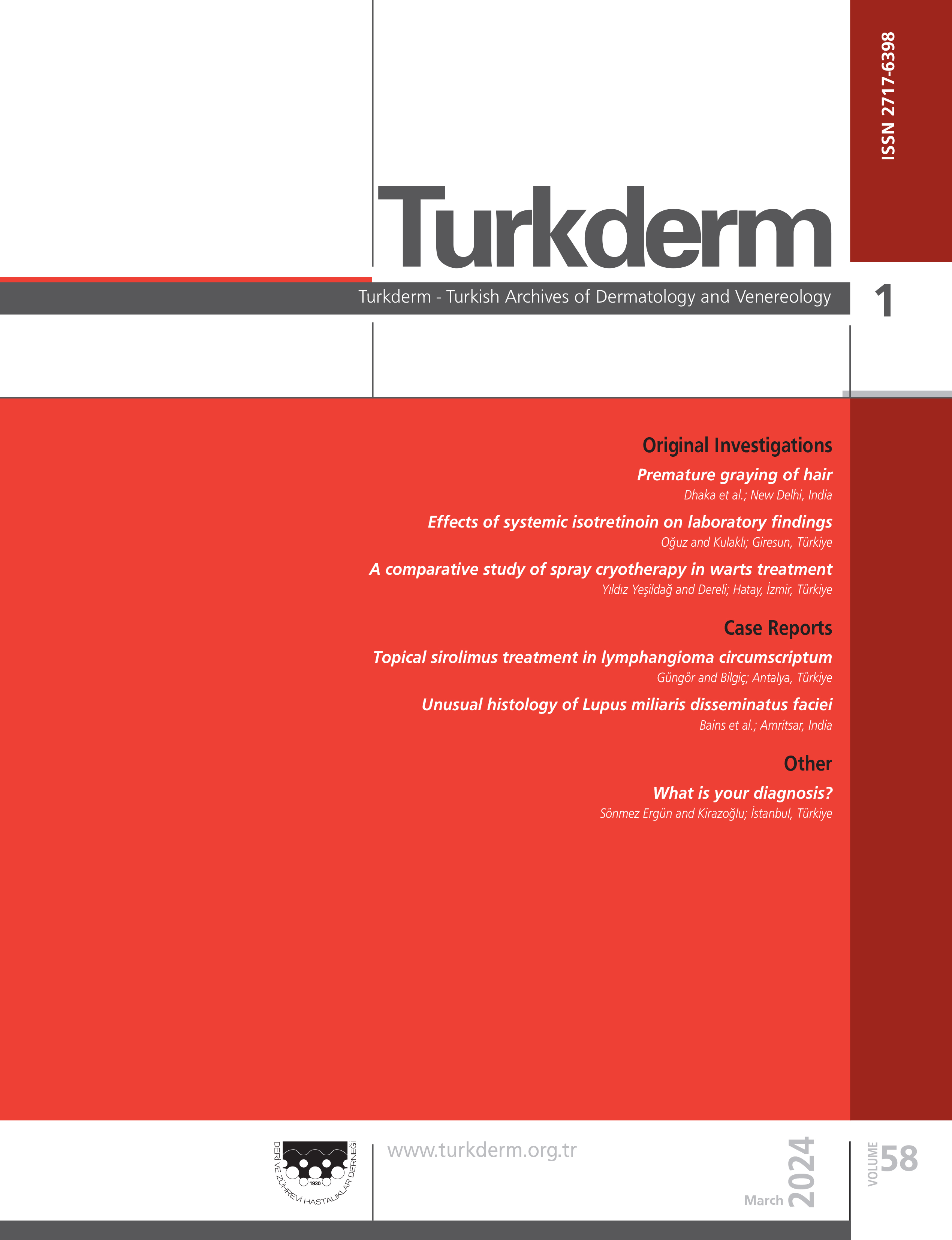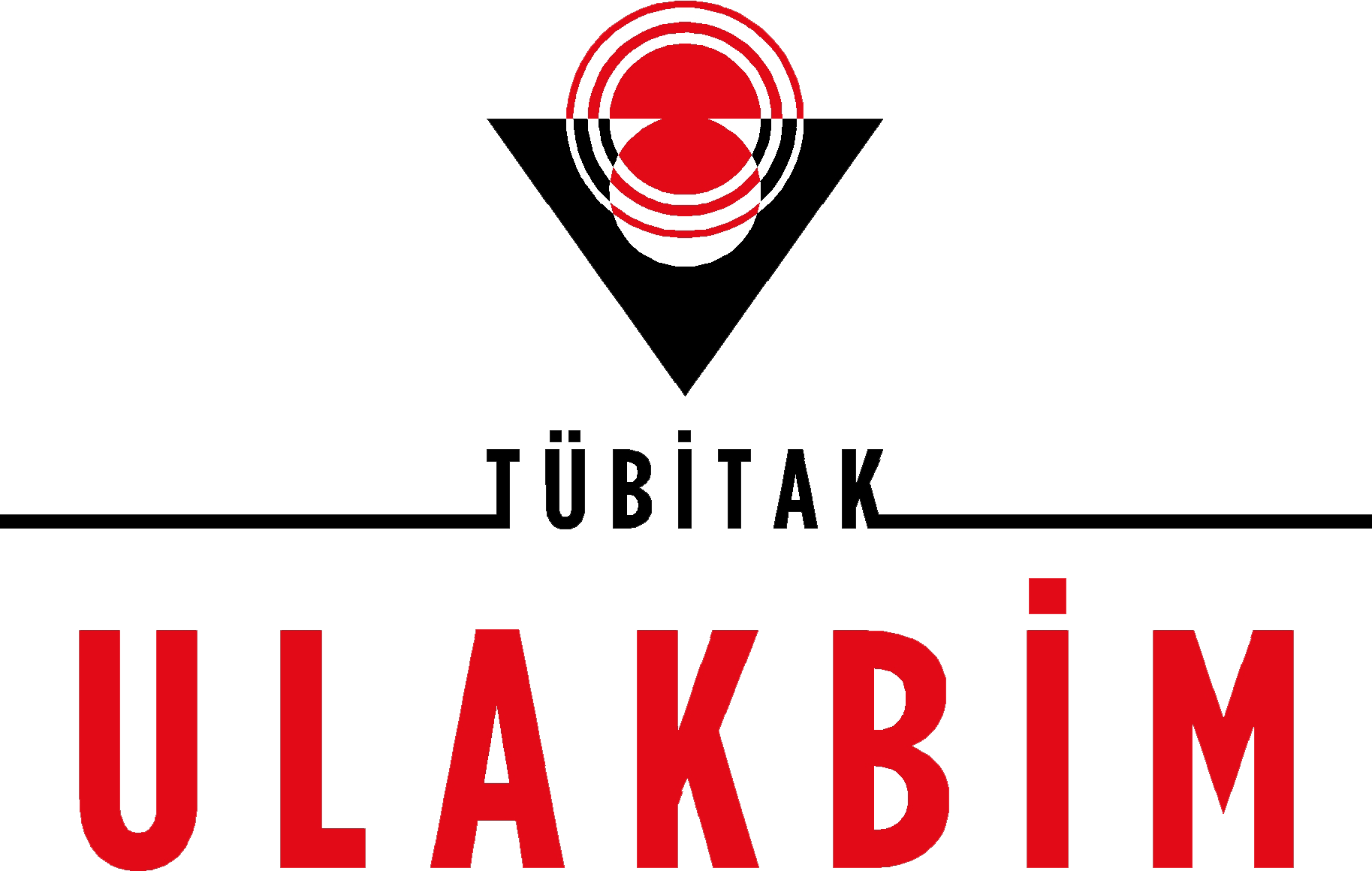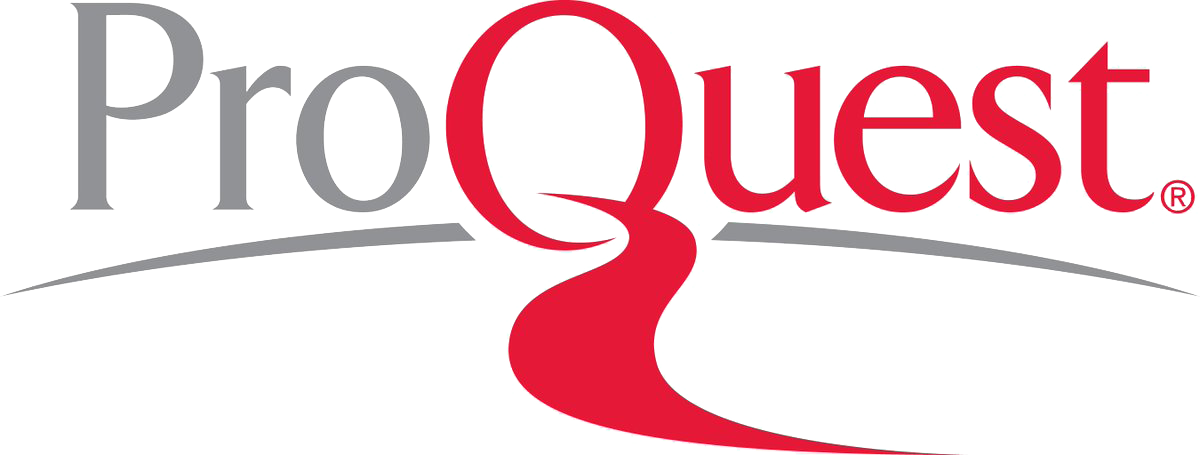Volume: 38 Issue: 3 - 2004
| BAŞYAZI | |
| 1. | Dermatoloji and charities Özgür Yürüker, Tuğba Rezan Ekmekçi, Adem Köşlü Pages 166 - 173 Sivil toplum örgütleri, kar amacı gütmeyen gönüllü ve hükümet dışı çalışan kuruluşlardır. Biz, çalışmamızda, dermatolojinin sahasına giren hastalıklarla ilgili var olan dernekleri tespit etmeyi ve bu dernekleri incelemeyi amaçladık. Internette arama motorlarına dermatoloji ile beraber foundation, society, association, group, organization anahtar kelimeleri yazıldı. Bu şekilde ulaşılan web sayfaları incelendi. Ayrıca her derneğe e-mail atılarak ek bilgi sağlandı. İnternette web sayfası bulunan toplam 26 dernek tespit edildi. Bu derneklerin tarihi, idari ve mali yapıları, gelir kaynakları, üyelik şartları, nasıl üye olunduğu, üyelikle elde edilen imkanlar, amaçları, eğitim faaliyetleri, süreli yayınları, sosyal aktiviteleri, araştırma destekleri ve iletişim fonksiyonları hakkında bilgi elde edildi. Bizlere yabancı gelen bu konuda, gelişmiş ülkelerin epey yol katettiği görüldü. Aradaki farkın kapatılması, sivil toplum gerçeğinin tüm toplum tarafından algılanması ve biz hekimlerin bu konulara ilgi duymasıyla mümkündür. Background and design: Charities are non-profit organizations that function independently of the government. In our research, we aimed to identify and investigate the foundations which represent diseases belonging to the field of dermatology. MATERIAL-METHOD: We searched for key words on the internet, namely by entering the word dermatology together with one of the following words: foundation, society, association, group, organization. The search result websites of organizations were explored and additional information was obtained by contacting these organizations by e-mail. RESULT: Twenty six such organizations were identified. Data was gathered on these organizations and about their history, management structure, income, membership procedures and benefits, targets and goals, training facilities, publishing, research grants and communication functions. CONCLUSION: We concluded that unlike in Turkey, the field of dermatological foundations are quite advanced in developed countries. It is possible bring Turkey up to the same level by a higher level of involvement from doctors and making the public more aware of these types of foundations and their functions. |
| REVIEW ARTICLE | |
| 2. | New biological agents in treatment of psoriasis. Ayten Ferahbaş Pages 174 - 184 Psoriazis patogenezindeki spesifik basamakları hedefleyen birçok yeni biyolojik tedaviler geliştirilmiştir. Bunlar; T hücreleri, T hücre aktivasyonu, T hücre migrasyonu ve sitokinlerin hücresel üretim ve sekresyonunu direkt etkiler. Bizler psoriazisli hastalarımızın tedavisinde biyolojik ajanların kullanımına karar verirken bunların potansiyel yarar ve risklerini iyi bilmeliyiz. Burada psoriazis tedavisinde kullanılmaya başlanan biyolojik tedavi ajanları literatür bilgileri eşliğinde gözden geçirilmiştir. Several new biological therapies have been developed, which target specific steps in the pathogenesis of psoriasis, including direct effects on T cells, T cell activation, T cell migration, and cellular production and secretion of cytokines. Dermatologists should be familiar with the potential benefits and risks of these therapies to make rational decisions concerning their use in the treatment of their patients with psoriasis. Here in, the biological agents that are currently being used in the treatment of psoriasis are reviewed with knowledge of recent medical literature. |
| ORIGINAL INVESTIGATION | |
| 3. | Evaluation of anticardiolipin anticores and tendency of thrombosis in cutaneous vasculitis Pınar Yüksel Başak, Ali Adiloğlu, Çağnur Özcanlı, Rabia Can, Vahide Baysal Akkaya Pages 185 - 190 AMAÇ: Vaskülitlerde damar duvarındaki endotel hücre aktivasyonu ve inflamasyon ile birlikte antikardiolipin antikorların (ACA) trombus gelişimini kolaylaştırabileceği bildirilmiştir. Bu durum, vaskülit patogenezi, seyri ve doğru tedavi seçeneklerinin belirlenmesinde önem taşımaktadır. Çalışmamızda kutanöz vaskülitli hastalarda klinik ve laboratuvar açıdan tromboza eğilimin belirlenmesi amaçlanmıştır. GEREÇ-YÖNTEM: Çalışmaya klinik ve histopatolojik bulgularla kutanöz lökositoklastik vaskülit tanısı alan 18 hasta ile 18 sağlıklı kontrol alındı. Hasta grubu vaskülit etyolojisi açısından araştırıldığı gibi serumda protein C, protein S, antitrombin III düzeyleri, protrombin zamanı, parsiyel tromboplastin zamanı, kanama ve pıhtılaşma zamanları değerlendirildi. Hasta ve kontrol grubu serum ACA IgM ve IgG pozitifliği açısından karşılaştırıldı. BULGULAR: Hasta grubunda klinik ve laboratuvar bulguları açısından sistemik tutulum varlığına rastlanmazken trombotik risk faktörleri de normal olarak değerlendirildi. ACA IgG, iki olguda orta derecede yüksek olup kontrol grubunda negatif bulunurken ACA IgM olguların tümünde negatif idi. Hasta ve kontrol grubu arasında serum ACA IgG pozitifliği açısından fark saptanmadı (p=0.486, Fischerin exact testi). SONUÇ: Sistemik tutuluma ait bulgu yoksa kutanöz vaskülitin tromboza eğilim ve ACA pozitifliği açısından risk taşımadığı sonucuna varıldı. AIM: Endothelial cell activation and inflammation in the vessel wall along with anticardiolipin anticores (ACA) were reported to facilitate thrombus formation in vasculitis. This is important in means of the pathogenesis, progression and effective treatment alternatives of the disease. In the present study, it is aimed to reveal the tendency of thrombosis in cutaneous vasculitis with clinical and laboratory investigation. MATERIALS-METHODS: Eighteen patients diagnosed as cutaneous leukocytoclastic vasculitis with clinical and laboratory findings and 18 healthy controls were enrolled in the study. The etiology of vasculitis was investigated in the patient group as well as serum protein C, protein S, antithrombin III levels, prothrombin and partial thromboplastin time, bleeding and coagulation times. Patient and control groups were compared in means of serum ACA IgM and IgG positivity. RESULTS: Systemic involvement was not observed with clinical and laboratory investigations as well as thrombotic risk factors in the patient group. ACA IgM positivity was not detected in any of the groups while ACA IgG levels were moderately elevated in two patients whereas all of the controls were ACA IgG negative. There was no difference between patient and control groups in means of serum ACA IgG positivity (p=0.486, Fischers exact test). CONCLUSION: It was concluded that cutaneous vasculitis carries no risk of thrombosis and ACA positivity in the absence of systemic involvement. |
| 4. | Bone mineral density in patients receiving isotretinoin and acitretin Ferhan Cantürk, Nalan Saraç, Fatma Aydın, Fevziye Canbaz Tosun, Gamze Alaylı, Yeşim Akyol, Tayyar Cantürk Pages 191 - 194 İzotretinoin ve asitretin vitamin A türevi sentetik retinoidler olup, iskelet sistemi üzerine yan etkilerinin olduğu bilinmektedir. Çalışmamızda oral sentetik retinoid kullanan hastaların kemik mineral yoğunluğu ölçümlerini yaparak osteoporoz riski taşıyıp taşımadıklarını tespit etmeyi amaçladık. Çalışmaya 0.5 mg/kg/gün dozunda 16sı asitretin ve 3ü izotretinoin alan toplam 19 hasta alındı. Tedavi öncesinde ve 6. ayın sonunda lomber vertebraların (L2-L4) ve sol kalçanın (femur boynu ve trokanterik bölge) kemik mineral yoğunluğu ölçümleri (g/cm2) Dual Energy X-Ray Absorbsiometri ile yapıldı. Tedavi öncesi ve sonrası kemik mineral yoğunluğu ölçümlerinde istatistiksel olarak anlamlı bir fark saptanmadı (p>0.05). Sonuç olarak, düşük doz (0,5 mg/kg/gün) ve kısa dönem (6 ay) izotretinoin ve asitretinin kullanımının, lomber vertebra ve kalçada osteoporoz yapıcı etkisinin olmadığı bulundu. Background and design: Isotretinoin and acitretin, known as retinoids, are synthetic derivaties of vitamin A. They have been known to cause a variety of skeletal side effects. The aim of the study was to determine whether the patients receiving synthetic retinoids are under the risk of osteoporosis. MATERIAL-METHOD: Nineteen patients who received 0.5 mg/kg/day dose of acitretin (n=16) and isotretinoin (n=3) were included in this study. Bone mineral density (g/cm2) of left hip (neck, trochanter) and lumbar spine (L2-L4) were measured by Dual Energy X-Ray Absorptiometry before and at the sixth month of the therapy. RESULTS: We didnt find statistically significant difference in bone mineral density (p>0.05). CONCLUSION: Short term (six months) isotretinoin and acitretin with a low dose of 0.5 mg/kg/day were not due to osteoporosis at the lumbar spine and the hip. |
| 5. | Pityriasis lichenoides: a retrospective study involving 75 patients Sevil Özdöl, Gonca Boztepe, Ayşen Karaduman, Cansel Köse Gürer, Banu Çakır, Gül Erkin, Sedef Şahin Pages 195 - 198 Pitriyazis likenoides, akut ve kronik seyir gösterebilen, etyolojisi bilinmeyen bir deri hastalığıdır. Hastalığın seyrini ve prognozunu etkileyen faktörler kesinlik kazanmamıştır. Bu çalışmada, 1990-2002 yılları arasında klinik olarak pitriyazis likenoides et varioliformis akuta (PLEVA) ( n=17 ) ve pitriyazis likenoides kronika (PLC) ( n=58 ) tanısı alan 75 hastanın demografik ve klinik özellikleri, önerilen tedavilere yanıt ve nüks oranları retrospektif olarak incelendi. Bu iki hasta grubu arasında yaş, cinsiyet, tanı alana kadar geçen süre ve lezyonların dağılımı açısından fark yoktu. Onyedi PLEVA hastasının 4üne fotobiyolojik yöntemler, 8ine diğer tedaviler ( sistemik ve topikal ) önerilirken, 58 PLC hastasının 32sine fotobiyolojik yöntemler, 20sine diğer tedaviler önerildi. Tedavi sonrası izlemi olan 6 PLEVA hastasının 3ünde, 43 PLC hastasının 34ünde tedaviye yanıt saptandı. Yanıt sonrası izlemi olan 2 PLEVA hastasının 1inde, 26 PLC hastasının 13ünde nüks izlendi. PLC hastalarının uygulanan tedavi ile tedaviye yanıtları arasında istatiksel olarak anlamlı bir ilişki bulunmadı. Benzer şekilde yanıt ve nüks ile lezyonların dağılımı arasında da, istatiksel olarak anlamlı bir ilişki yoktu. Bu çalışma, PLEVA ve PLC arasında demografik özelliklerin ayırt edici olmadığını göstermektedir. Ayrıca, PLC tedavisinde fotobiyolojik yöntemler ve diğer tedavilerin klinik düzelmede belirgin bir fark yaratmadığını ve lezyonların dağılımının tedaviye yanıtı ve nüksü etkilemediğini düşündürmektedir. Backround and design: Pityriasis lichenoides, which is usually classified as acute and chronic forms, is a cutaneous disease of unknown origin. The clinical course and factors affecting the prognosis are not well defined. MATERIAL-METHOD: In this study, 75 patients who were diagnosed clinically as PLEVA (n= 17) and PLC (n=58) between the years 1990 and 2002 were retrospectively investigated in terms of their demographic and clinical properties, response and recurrence rates. RESULTS: There were no statistically significant differences for gender, age, time till the diagnosis and the distribution of lesions between the two groups. While 4 of 17 PLEVA patients were suggested photo-biologic methods, eight were suggested other treatments (systemic and topical). Thirtytwo of 58 PLC patients were suggested photo-biologic methods whereas 20 of them were suggested other methods. Three of 6 PLEVA and 34 of 43 PLC patients had a clinically significant improvement with the suggested treatments. One of 2 PLEVA patients and 13 of 26 PLC patients have recurrence. There was no statistically significant difference between the treatments applied to the PLC patients and their response to the treatment. In the same manner, no statistically significant relationship was found between the response and the distribution of the lesions. CONCLUSION: This study shows that the demographic properties of PLEVA and PLC patients are not distinguishing. Moreover, it might suggest that the photo-biologic methods and other treatment methods do not create an evident difference in clinical improvement and the distributions of the lesions do not affect the response and recurrence rates. |
| 6. | Efficacy of topical erythromycin, tetracycline and clindamycin in the treatment of acne vulgaris Mustafa Peker, H. Bülent Taştan, Ercan Arca, A. Hakan Erbil, Ali Rıza Gür Pages 199 - 207 Topikal antibiyotiklerden eritromisin, tetrasiklin ve klindamisin akne tedavisinde yaygın olarak kullanılmakta olup özellikle hafif ve orta derecede inflamatuar aknede etkilidirler. Çalışmada bu ilaçlar arasında tedavi etkinliği açısından bir fark olup olmadığının araştırılması amaçlandı. Bu karşılaştırmalı çalışmada hafif ve orta derecede akne vulgarisli altmış olguda on iki haftalık topikal tetrasiklin, eritromisin ve klindamisin tedavilerinin etkinlikleri karşılaştırıldı. Çalışmada yirmi olguya tetrasiklin, yirmi olguya eritromisin ve yirmi olguya da klindamisin verildi. İlaçlar on iki hafta süreyle sabah-akşam olmak üzere günde iki kez uygulandı. Gruplar arasında yaş, akne başlama yaşı, akne derecesi, cinsiyet ve meslek yönünden istatistiksel olarak anlamlı fark yoktu (p>0,05). Çalışma sonunda her üç ilaçla da istatistiksel olarak anlamlı düzelme saptandı (p<0,05). Toplam lezyon miktarındaki azalma tetrasiklin ile %57,95, eritromisin ile %57,97 ve klindamisin ile %39,5 olarak saptandı. Tetrasiklin ile eritromisin arasındaki fark istatistiksel olarak anlamlı değilken (p>0,017), tetrasiklin-klindamisin ve eritromisin-klindamisin arasındaki fark istatistiksel olarak anlamlı bulundu (p<0,017). Topikal tetrasiklin, eritromisin ve klindamisinin hafif ve orta derecede akne vulgariste etkin ve güvenilir olduğu, ancak topikal klindamisinin, eritromisin ve tetrasiklinden daha az etkin olduğu ve yan etki insidansının daha yüksek olduğu kanısına varıldı. Background and design: Topical antibiotics such as erythromycin, tetracycline and clindamycin are widely used and effective on mild and moderate inflammatory forms of acne. In this study it was aimed to clarify the efficacy of these drugs and determine if there is a difference between them according to the efficacy. METHODS: In this study, we compared the efficacy of topically applied tetracyclin, erythromycin and clindamycin for twelve weeks in randomized sixty cases with mild and moderate acne vulgaris. Sixty cases were divided into three groups and treated with tetracycline, erythromycin and clindamycin. Drugs were applied topically two times a day for twelve weeks. RESULTS: There was no statistically difference of age, duration, acne score, gender and occupation between the groups (p>0.05). Clinical improvement was obtained with all drugs (p<0.05). Total lesion reduction ratio was 57.95%, 57.97% and 39.5% with tetracycline, erythromycin and clindamycin, respectively. While there was no statistically difference between the tetracycline and erytromycin groups (p>0.017), tetracycline and clindamycin and erythromycin-clindamycin groups differed from each other with statistical significance (p<0.017). CONCLUSION: It was concluded that topically applied tetracycline, clindamycin and erythromycin are safe and effective in mild and moderate acne vulgaris, but topical clindamycin is the least effective, and has more side effects than the tetracycline and erythromycin. |
| TURKDERM-9860 | |
| 7. | Mycosis fungoides resembling pigmented purpuric eruption: case report Emine Tamer, Muharrem Üstün Polat, Güneş Gür Toy, Nurdan Lenk, Nuran Allı, Özge Han Pages 211 - 214 Mikozis fungoides alışılmadık kutanöz lezyonlarla karşımıza çıkabilir. Bu farklı lezyon spektrumunda pigmente purpurik erüpsiyona benzer klinikle kendini gösteren mikozis fungoides de yer alır. Burada histopatolojik olarak MF tanısı alan, klinik olarak pigmente purpurik dermatozu taklit eden bir hastayı sunuyoruz. Mycosis fungoides present with unusual cutaneous lesions. Pigmented purpuric eruptions are in the spectrum of atypical lesions of mycosis fungoides. Here we present a patient diagnosed histopathologically as mycosis fungoides, that clinically resembled pigmented purpuric dermatitis. |
| 8. | A case of lymphogranuloma venereum with unknown transmission site Özgül Çoban Balık, Cihangir Aliağaoğlu, Zeki Çabuk Pages 216 - 217 Lenfogranuloma venereum Chlamydia trachomatisin neden olduğu cinsel yolla bulaşan ve nadir olarak görülen bir hastalıktır. Bu yazıda bilateral çok sayıda inguinal lenfadenopati ve ülserasyon gösteren, bulaşyolu tesbit edilemeyen bir lenfogranuloma venereum olgusu sunulmuştur. Lymphogranuloma venereum is a rare form of the sexually transmitted disease caused by Chlamydia trachomatis. In this manuscript a case of lymphogranulaoma venereum with unknown transmission site is presented. |
| 9. | Porokeratozis Disseminated superficial actinic porokeratosis with the histology of porokeratosis Mibelli Neslihan Dolar, Server Serdaroğlu, Cuyan Demirkesen Pages 220 - 223 Porokeratoz, ender görülen bir keratinizasyon bozukluğu olup ortası atrofik, çevresi keratozik, deriden kalkık bir kenarla çevrili halka şekilli lezyonlarla karakterize bir tablodur. Patogenezi tam olarak anlaşılamamış olan bu hastalık grubunun 5 tipi tanımlanmıştır. Burada polikliniğimize başvuran ve tanısı klinik olarak dissemine süperfisyel aktinik porokeratoz ile uyumlu olup histopatolojik olarak porokeratozis Mibelli özellikleri gösteren 47 yaşındaki bayan hasta sunuldu. Porokeratosis is an uncommon disorder of keratinization characterized by annular lesions with central atrophy, raised hyperkeratotic border. Porokeratosis is a disorder of uncertain cause. Five different types of porokeratosis have been described. We describe a 47-year old woman suggesting disseminated superficial actinic porokeratosis with clinical and porokeratosis of Mibelli with histologic findings.. |
| LETTER TO THE EDITOR | |
| 10. | Meyerson Nevusu Tuğba Rezan Ekmekçi, Adem Köşlü, Damlanur SakızPages 224 - 225 Abstract | |
| TURKDERM-6637 | |
| 11. | Yeni Mekanlar, Yeni Toplantılar Page 226 Abstract | |
| 12. | Haber Sayfası Page 227 Abstract | |
| EDITORIAL | |
| 13. | Dermatoloji Yeterlilik Kurulu Çalışmalarına Başladı Oya GürbüzPages 246 - 247 Abstract |






















